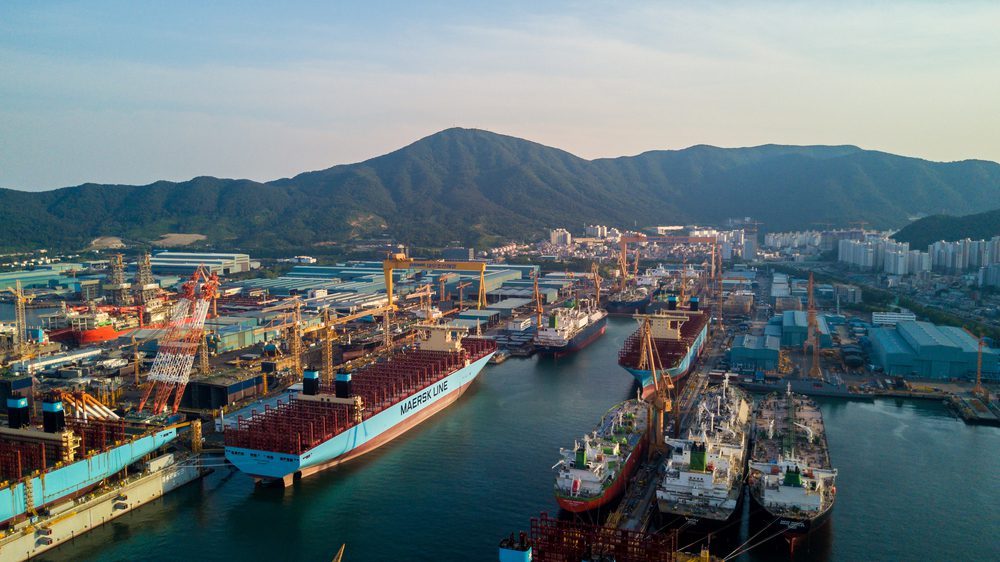Daewoo Shipbuilding & Marine Engineering shipyard. File Photo: Panwasin seemala / Shutterstock.com
By Heejin Kim and Kyunghee Park (Bloomberg) — Park Hong-sik, a fund manager who correctly predicted the rally of South Korean technology stocks in 2017, has a new bet for this year: Shipbuilders.
Four of the world’s five best-performing major shipbuilders this year are from South Korea, including Daewoo Shipbuilding & Marine Engineering Co., which has rallied 94 percent, according to the Bloomberg Intelligence Asia Shipbuilding Valuation Peers Index. The worst three performers were all Chinese shipmakers, such as China CSSC Holdings Ltd. The MSCI Asia Pacific Index has fallen about 1 percent this year.
“Both prices of ships and quantities of orders show signs of rebounding.” said Park, chief investment officer at Macquarie Investment Management Korea. “There’s an expectation of a turnaround.”
South Korea to Offer ‘Industry Crisis’ Funding to Hard-Hit Shipbuilding Regions
Park’s optimism stems from an uptick in orders across the global shipbuilding industry, in which South Korean yards are the world leaders. They are starting to see their aggressive restructuring, including thousands of job cuts, and government support bear fruit after years of losses. While China’s shipbuilding industry has also undergone a revamp, it still faces challenges and continues to consolidate.
Daewoo Shipbuilding, Hyundai Heavy Industries Co., and Samsung Heavy Industries Co., the world’s top three shipyards, are all based in South Korea. Industry leader Hyundai Heavy said in April that a recovery in ship prices will be more evident in the second half of this year, driven by demand for those carrying containers, liquefied natural gas and oil.
Park’s Macquarie New Growth Securities Master Investment Trust fund held shares in all three shipbuilders as of Dec. 31, according to data compiled by Bloomberg. He said the fund has been increasing its holdings in South Korean yards since the start of this year, and is keen on firms with the capability to build LNG-related facilities, such as regasification units.
The fund returned 33 percent in 2017 by focusing on technology stocks including Samsung Electro-Mechanics Co. and BH Co., beating most of its peers and the benchmark Kospi index.
Separately, Park Moo-hyun, an analyst at Hana Financial Investment, said South Korean yards are regarded in the industry as the only solution for making LNG carriers, largely because of their more technologically advanced skills compared with Chinese shipbuilders.
Shipyards could also benefit from stricter environmental regulations, including the International Maritime Organization’s limits on sulfur emissions set to take effect on Jan. 1, 2020. Vessel owners may look to order new ships powered primarily by LNG to help meet the tighter rules.
The top three shipbuilders received orders for 68 vessels worth $8.7 billion in the first four months of 2018, double the 34 valued at $4.4 billion in the same period a year earlier, according to Hanwha Investment & Securities Co.
Higher Prices
Vessel prices have risen since the second half of 2017, the first increase since 2014. Clarkson Plc’s ship price index, which tracks the prices of all types of commercial vessels, reached 128 in May, rising from 121 in April last year, according to Lee Jae-won, an analyst at Yuanta Securities Korea Co. in Seoul.
The most recent order for a very large crude carrier was priced at $92 million, rising from $87 million for a similar vessel earlier this year, Hana Financial’s Park said.
A challenge remains on how South Korean yards can keep prices competitive with Chinese rivals. And while orders are rising, it will take another two years before these will be reflected in their earnings.
South Korean Shipyards in Tough Battle with Undercutting Chinese Rivals
In addition, there is concern about the South Korean shipbuilders’ profitability, which remains low due to increased costs of raw materials such as steel plates. Hana Financial’s Park estimates the big three will post an average operating margin of 1.8 percent this year.
The possible combination of China’s two biggest shipbuilding groups also poses a threat, since the merged builder will have a strong financing backing and other forms of state support, according to Rahul Kapoor, an analyst at Bloomberg Intelligence in Singapore.
© 2018 Bloomberg L.P

 Join The Club
Join The Club











